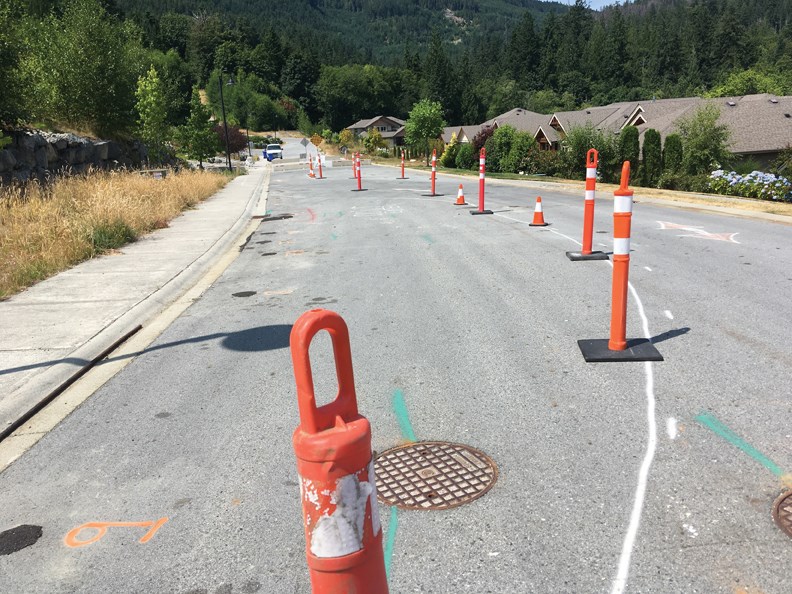A new sinkhole has been found on Gale Avenue North in the Seawatch subdivision and the problem appears to be extending southward, towards the Shores development, according to a report from Thurber Engineering Ltd.
The District of Sechelt asked Thurber to investigate after a visible crack was found around one of the manhole covers on Gale Avenue North.
The company did some drilling and testing in early July and found a new sinkhole had developed beneath the surface of the roadway. The area had previously been flagged by the company as one to watch.
Sechelt Mayor Bruce Milne said district staff had been monitoring the area regularly “as part of the ongoing program of assessment,” and now the district is “seeking further information to determine whether additional work should be completed in the near future.”
To date the district has admitted no liability in the formation of sinkholes at the Seawatch subdivision, including the one that ultimately forced homeowners Ross and Erin Storey to vacate their house with their three children in February 2015.
The newly found sinkhole caused the district to block off more of Gale Avenue North (a portion of it was already closed in front of the Storey home) and create a detour in early July.
“Based on the information presently available to the district, the detour is safe,” Milne said.
However, the report from Thurber suggests more sinkhole formation will happen at the Seawatch subdivision soon, possibly under the municipal roadway or someone’s home.
“If measures are not taken soon to control the ongoing erosion of subsurface soils, new sinkholes will likely develop in the near term,” the report stated.
“Further, the piping erosion may expand south and southeast beyond the site boundary, affecting neighbouring roads and properties (if they are not already affected).”
When asked if the district planed to warn property owners to the south of the sinkhole issue, Milne said no.
“There is no new information in recent reports that indicate it would be necessary or prudent to notify nearby property owners of the geotechnical conditions associated with Concordia Seawatch development,” he said.
When asked if new developments would be allowed by council to the south and southeast of Seawatch before the sinkhole issue is fixed, Milne said, “We simply do not know. We cannot provide categorical answers to hypothetical situations.”
Sechelt has encouraged those affected by the sinkholes to sue, as the issue is being handled by the Municipal Insurance Agency now and a lawsuit would help enhance “the prospect of reaching a mutually satisfactory omnibus solution” to the problem, Milne said.
The district has also recently launched a lawsuit of its own against the company that developed the Seawatch subdivision, Concordia Seawatch Ltd., for restitution in the amount of $465,519.55.
The funds are outstanding from two invoices for investigation and remedial work done by the district at the site that were sent to Concordia in 2015.
The lawsuit, filed in B.C. Supreme Court on July 20, shows that the district has a save harmless covenant on the Seawatch site that was signed in 2006, which appears to single out Concordia as the company responsible for fixing the sinkhole issue in Seawatch.
The covenant says Concordia Seawatch Ltd. “hereby releases, saves harmless and indemnifies the municipality for any damage, loss, claim, demand, cost (including legal cost), whether as a result of injury or death to any person, or damage to property of any kind, including any claims by third parties … whether or not construction is in accordance with the geotechnical assessments referred to herein, including without limitation any subsidence, settling of any structure including any utility or road infrastructure, loss of slope stability, or any similar matter.”
The covenant signed by Concordia also states the municipality “has no specific knowledge and makes no representations or warranties regarding the geotechnical adequacy of the lands for the proposed uses.”
Concordia Seawatch has yet to file a response to the civil claim.
In the meantime, Thurber has recommended the District of Sechelt address underground water management issues that appear to be contributing to the ongoing sinkhole formation at Seawatch.
Milne said it’s “a very complicated subject. At present, the district is monitoring the situation, and seeking professional advice whenever we have information which warrants doing so.”
Homeowners in the Seawatch subdivision have been made aware of the new sinkhole and have been provided copies of Thurber’s most recent report.



